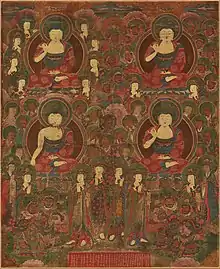Buddhist painting
Buddhist painting, Butsuga (仏画) in a broad sense, refers to Buddhist paintings in general, including Buddhist biographies, Jataka tales, Pure Land variant paintings (such as Taima mandala), Raigō, Buddhist narrative paintings such as the Two Rivers White Path and Six Paths paintings, Ancestors biographies, Emaki, E-toki, Ancestors drawings, Chinsō portraits of Zen monks, and portraits of ordinary monks. Chinsō, portraits of Zen monks, and portraits of ordinary monks.[1]

Narrowly defined, a painting used in the worship and rituals of Buddhism, especially esoteric sects. Paintings (single or group) depicting the Buddha (Tathāgata), Bodhisattvas, ancient Indian gods, Chinese and Japanese gods, and other deities worshipped in Buddhism, as well as Mandala of the Two Realms, Mandala of the Separate Realms, etc.
Buddhist paintings include not just framed paintings but also include mandalas, hanging scrolls, and prints[2]
See also
- Kirikane - The decorative techniques of Buddhist painting handed down from the Asuka period
- Silken Painting of Emperor Go-Daigo
References
- 第2版, 日本大百科全書(ニッポニカ),ブリタニカ国際大百科事典 小項目事典,百科事典マイペディア,精選版 日本国語大辞典,デジタル大辞泉,世界大百科事典. "仏画とは". コトバンク (in Japanese). Retrieved 2022-02-19.
{{cite web}}: CS1 maint: multiple names: authors list (link) - 仏壇・仏具のことなら「いい仏壇」, はじめてのお仏壇ガイド | (2021-04-01). "仏画とは". はじめてのお仏壇ガイド | 仏壇・仏具のことなら「いい仏壇」 (in Japanese). Retrieved 2022-02-19.